The Big Interview
‘You Just Have to Enjoy It’: Swiss Art Star Nicolas Party on His Evolution From Outlaw Street Artist to Art-Market Darling
The artist speaks to Andrew Goldstein about his scrappy beginnings and recent rise to prominence.

The artist speaks to Andrew Goldstein about his scrappy beginnings and recent rise to prominence.

Andrew Goldstein

As we look out onto the horizon of 2020, there are several major shifts underway in the art world. After a period of focus on correcting errors in the art-historical canon, the pendulum is swinging back in the direction of young artists who can inject new ideas and innovative approaches into the mix. If you ask anyone in the know who of this next generation you should be looking at, one of the names you’re sure to hear is Nicolas Party, a genial, 39-year-old Swiss artist who has won widespread attention not for his high-tech artistry, but rather for the opposite.
Party specializes in a relatively traditional form: portraits, landscapes, and still-lifes that he executes in vividly colored pastels, a painting technique developed during the Renaissance.
What results is a pictorial world so over-abundantly rich that you can all but taste it. Party pushes this effect into overdrive by bathing the walls of his galleries in gorgeous color, often adding surrealistic elements like floating jellyfish or flapping cartoon birds on top.
The artist currently has a ravishing show on view at New York’s Flag Art Foundation, where he is displaying his own work alongside that of historical artists he admires, like Marsden Hartley and Mary Cassatt. Party is also preparing for his debut exhibition with Hauser & Wirth—the Swiss gallery that signed him to its roster last June as one of its youngest artists ever—in Los Angeles this February.
So where does Party’s beguiling art come from, and what does it feel like to be a rising art star in 2020? The artist sat down with Andrew Goldstein at Artnet News’s headquarters to discuss.
Click here to listen to an audio version of this interview on our Art Angle podcast.
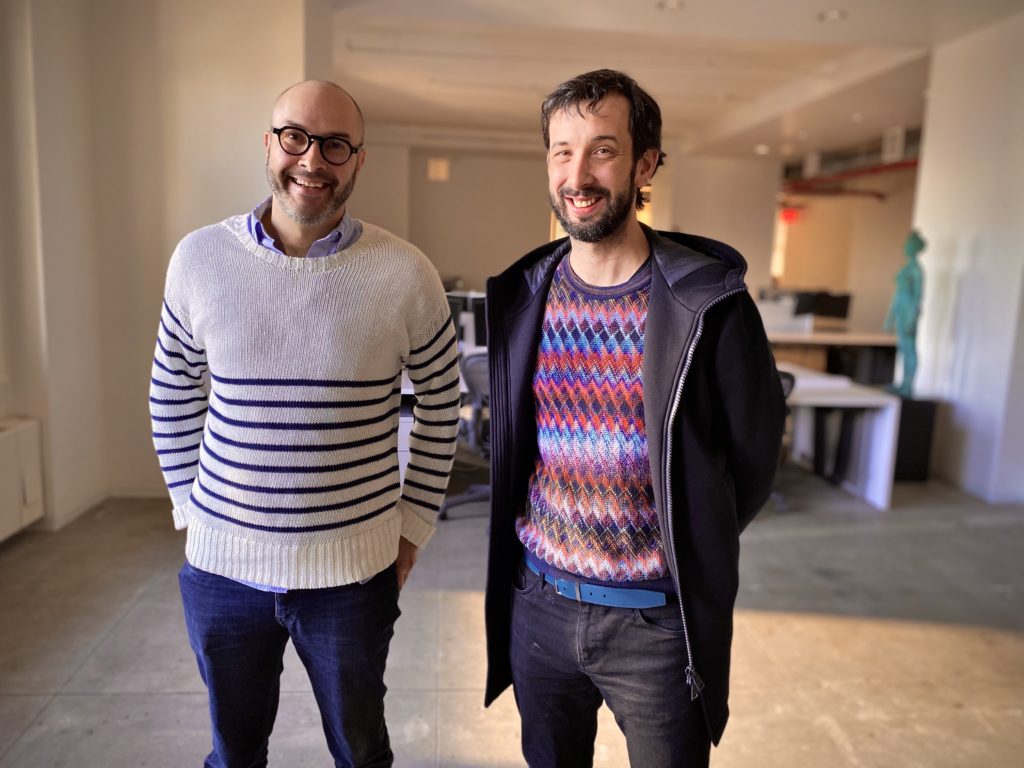
Artnet News editor in chief Andrew Goldstein with artist Nicolas Party. Photo: Tim Schneider.
So you grew up in Lausanne, Switzerland, which is a beautiful city overlooking the Alps. How did you first become drawn to making art?
When you’re a small child, six or seven years old, you have a certain amount of playtime and creative time allowed. [From then onward,] I never stopped doing it.
In your shows, you have a penchant for drawing on the walls. Is that something you did as a kid as well?
Yes! As a kid, they give you a small piece of paper that is the surface that’s allowed—but yeah, I’m sure I did some drawing on the walls where I wasn’t supposed to.
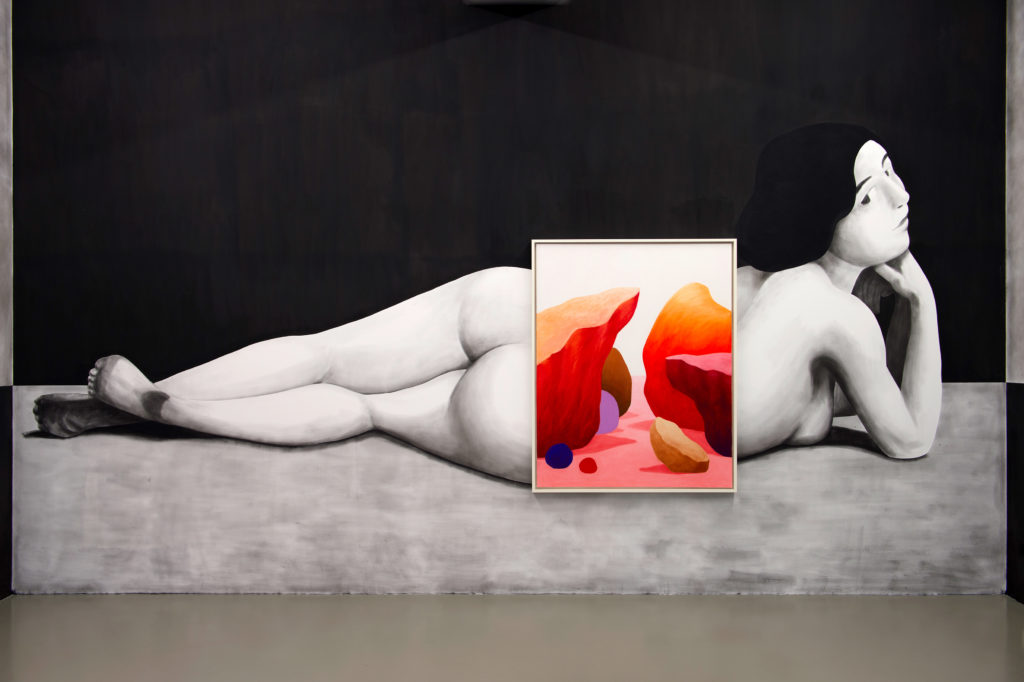
Installation view, “Pastel et nu,” Centre Culturel Suisse, Paris, France, 2015. ©Nicolas Party. Courtesy the artist, Hauser & Wirth, and Centre Culturel Suisse, Paris. Photo by Marc Domage.
And in fact, for a long time, you were a street artist, which is another form of drawing on the walls. What was that like, doing graffiti in Switzerland in the ’90s?
It was probably from when I was about 12 to 21, when I had a very tight-knit group of friends; we were going out at night together, getting chased by the police, hiding things, dressing up to blend in at night, breaking into some places. These things create a very strong bond, just as it would if you were into skateboards or were in a rock band.
At that particular moment in the ’90s, it was extremely exciting to be involved in graffiti. It was probably the second or third wave in Europe. Growing up in a small town, we only had one printed magazine about graffiti, and it was a revolutionary thing for us to discover, and basically we just kept trying to mimic that.
In street art, it is really important to develop a signature style, because that’s the only way that somebody walking down the street is able to recognize who did what. Did you have a visual catchphrase as an artist?
It’s strangely a very conservative kind of environment. I remember when I was doing block letters without perspective, and that was not seen as real graffiti. The signature was really the [artist’s chosen] name, and it’s usually four letters because that’s the right amount of space to fill in a short amount of time. Basically, you choose letters to form a word—of course, it has to be a name that’s not yours. It’s very similar to advertising logos.
My particular thing was to be a bit more skilled in terms of figuration, because I was drawing a lot, and not just doing the letters. Most people didn’t do characters, the kind of goofy heads and stuff that I was working with, these sort of monster creatures. It was a very fun and creative thing for me, and you just feel so alive.
I’ve got to ask, what was your tag?
My tags were “SEAM” and “REAL”—that’s what I tagged a lot of trains with. I can say that now because I got caught. You never want to keep the tag for too long, because that’s just stupid.
Well thank you for telling us that now! The police will be waiting for you.
It took me about 10 years to pay back all of the fines.
Wow, okay. So how did you transition from the cool, dangerous world of street art to the stuffy realm of “fine art”?
While I was doing the graffiti, I was actually still doing a lot of fairly traditional landscape painting. That environment is quite picturesque, but it got complicated with the police for a time. It’s fun, but spending nights in jail, you know, it gets old. It took years for me to believe that I could find the same thrill, that kind of joy of belonging to a group of friends again. Art school is such a great opportunity, but I was still missing that thrill, the adrenaline. Doing murals right now, it’s similar in that it’s a very physical environment and there is a time constraint—I was really chasing that sort of performance aspect.

Installation view, “Arches,” M Woods, Beijing, China, 2018. ©Nicolas Party. Courtesy the artist, Hauser & Wirth, and M Woods, Beijing.
How did you go from working with spray paint to this really genteel medium of pastels, which very few other artists have made their signature technique since the 1800s?
That was fairly recent. For a long time, I was working with oil painting, but it was just very slow—I was struggling with the idea that a work could take a year and a half to complete. It was just too long. I got interested in pastels because I saw a little portrait by Picasso at a show in Basel, a work that was from a series influenced by Greek sculptures. I think he used pastels because it was a sort of loose rendering, and the shading was so smooth.
And I just immediately connected to that work and thought pastel would be a great medium to do the shading in my portraits. I went straight to the museum store and bought a little postcard of the work, and the next day, I got a little box of pastels and paper, and I spent that summer copying the portraits, more or less. It goes so quickly; it’s such an immediate medium.
Instead of taking this in an abstract direction, you decided to make landscapes, still-lifes, and portraits—these really traditional, bourgeois, domestic, recognizable historical art forms. How were you drawn to this approach?
I was always taught in school that you need to have context for everything you create. I tried to think of elaborate themes: you know, “I’m doing this because it means that and it’s related to this text.” But I wasn’t connecting with any of it. I got more and more frustrated with my teachers, feeling how the Impressionists must have felt when they said, “We don’t want to do history paintings anymore.” As a reaction, they did still-lifes and landscapes, the most minor or underappreciated genres.
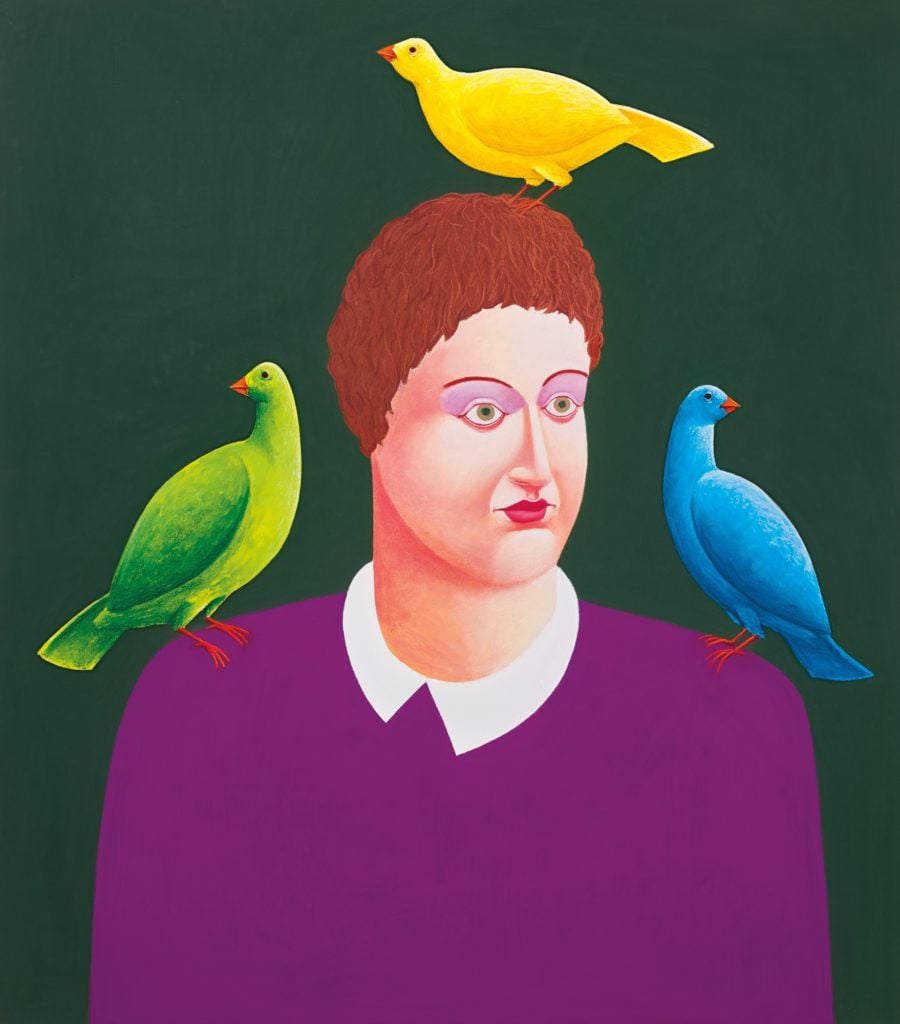
Nicolas Party, Portrait (2015). Courtesy of Sotheby’s.
You are using traditional tropes, but your approach is very uncanny, and that’s something that people really respond to. Your portraits seem to be a bit of a cross between ancient Etruscan art—with these huge mysterious almond eyes—and illustrator Edward Gorey. Are these real people that you’re painting, or are they archetypes?
Traditionally, if I do a portrait of you, I will name the painting after you. So if you’re painting someone and you remove the “someone,” you’re just seeing that first layer, the first few millimeters of something—as if I were putting makeup on the face and not including all of what’s inside. Like the famous story with Christ in his last few hours, when he gets fabric put on his face.
The shroud of Turin.
Exactly. At art school, I had a lot of freedom to work with animations—I was loving creating the volume and the surface of things. When social media came along, I was using a lot of Photoshop, and I really love this idea of working on the surface of things to make them more appealing. More and more, we’re living in the time of the filter—with Instagram, you always have a filter to make you look pretty or older or younger. The portraits are like those filters.
Your work is responsive to Instagram because you place your paintings in settings against a backdrop of architectural interventions like curved archways and painted walls, so everything pops out. How do you think about your work in regard to Instagram?
Painters back in the day used a mirror to physically see from another angle. And I think the camera is even better than a mirror. When I’m doing an install, I take a lot of pictures so I can go home and look again and make changes.
When painters were creating works to hang in a church, they were thinking about the candlelight and working based on the physical conditions of where the painting would live. When people ask if I think about Instagram, of course I do. Everything is influenced by the screen; we’re all post-Internet artists now.
You were born in 1980, which by some accounting techniques makes you a millennial, and now you’re speaking like a true millennial. Last summer, you became one of the youngest artists to join Hauser & Wirth, the gigantic mega-gallery that straddles the world with 11 locations internationally. Your cohort of artists is pretty rock-solid: Amy Sherald, who painted Michelle Obama’s portrait, Rashid Johnson, who just had his directorial debut with Native Son last year, and Avery Singer, who is this incredibly hot phenomenon right now. This is your new crew.
It’s really great. I kept all the galleries that I work with, so now I have six different galleries, and I do really spend more or less the same amount of time with each of them. But when you jump to a mega-gallery, it’s totally different.
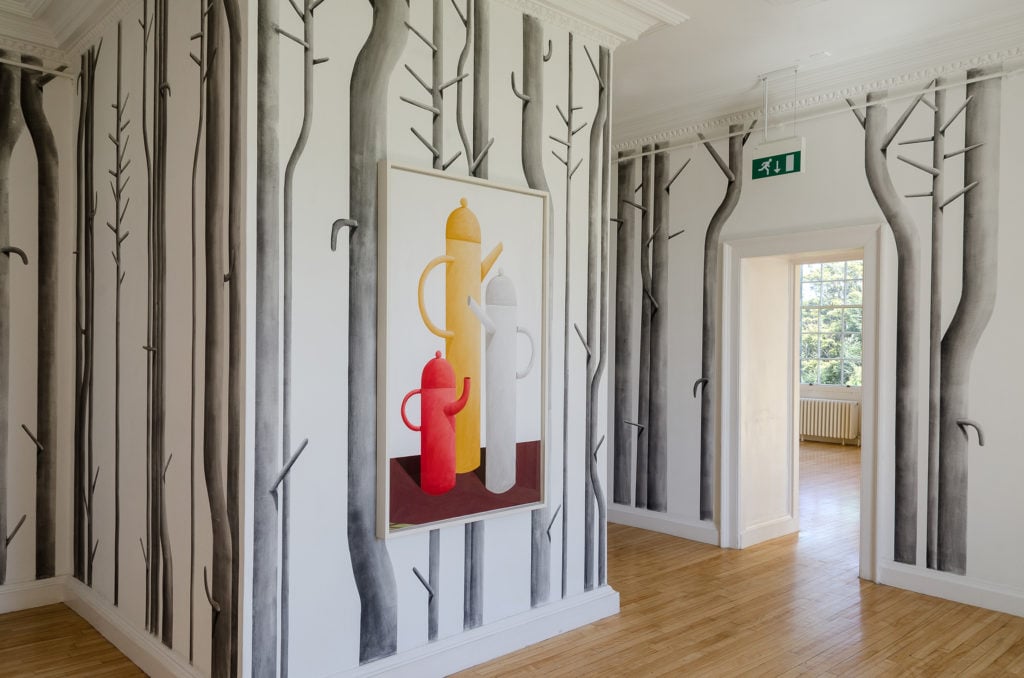
Nicolas Party, Boys and Pastel installation view at Inverleith House Courtesy of the artist and The Modern Institute/Toby Webster Ltd, Glasgow. Photography: Michael Wolchover.
With Hauser, it’s more like working with a museum because it is so large and has so many departments—communications, marketing, finance, install, sales. When I did my show at the Hirshhorn [Museum and Sculpture Garden in Washington, DC], there’s obviously a lot bureaucracy. You can’t just go in and say, “Oh, put this ladder here, and I’m going to paint this there.” The ladder has to be brought by a technical team and everyone has to agree on the changes in another meeting on another day. So for the big galleries, it feels similar, whereas in the smaller galleries, it’s much more direct. I’m very, very fortunate to have both structures.
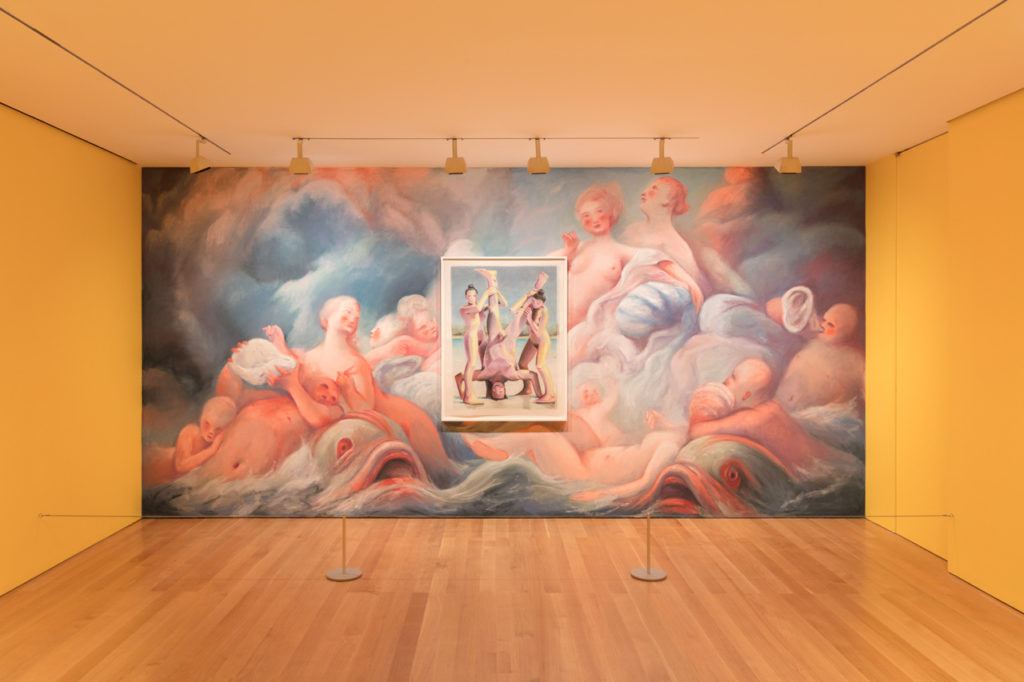
Installation view, “Nicolas Party: Pastel” at the FLAG Art Foundation. Photo: Steven Probert.
I imagine it as the difference between working for an independent movie studio and one of the big studios like MGM or Disney, where they can make your dreams come true with unlimited budgets. Another side effect—and this is always sensitive to talk about with an artist—is that since you joined Hauser & Wirth, the demand for your work has exploded. Prices for your work have quadrupled, and you broke the $1 million mark at auction in Hong Kong just a couple of weeks ago. How do you manage to compartmentalize that noise from the work?
Moving to New York was a big part of it. I don’t think [the art-market attention] could’ve happened if I had not established my studio here. The markets are here, and the money discussion is based here—certainly more than when I was in Glasgow. As soon as I moved here, I tried to embrace it. This is a capitalist city, almost like a caricature. My work that sold at the charity auction One Drop at Phillips made a very high price, but it was a strategic thing that was happening—certain galleries building it up. You have to get comfortable with the strategy that is in place. Some artists get really tense when you talk about it—you don’t want to say that you’re making so much more money than everybody around you.
For me, what’s happening right now is exciting, I’m lucky to have shows that I’m proud of and I work very hard for those shows, and the money helps me make those shows the best they can possibly be. I can have a great studio now, and as you know, rent in New York is insane. So I’m selling these paintings for very high prices, I can have an amazing studio and a few people to help me, but I am extremely lucky to have that. For 10 years I didn’t, and, to be honest, it’s much better now, no doubt about it.
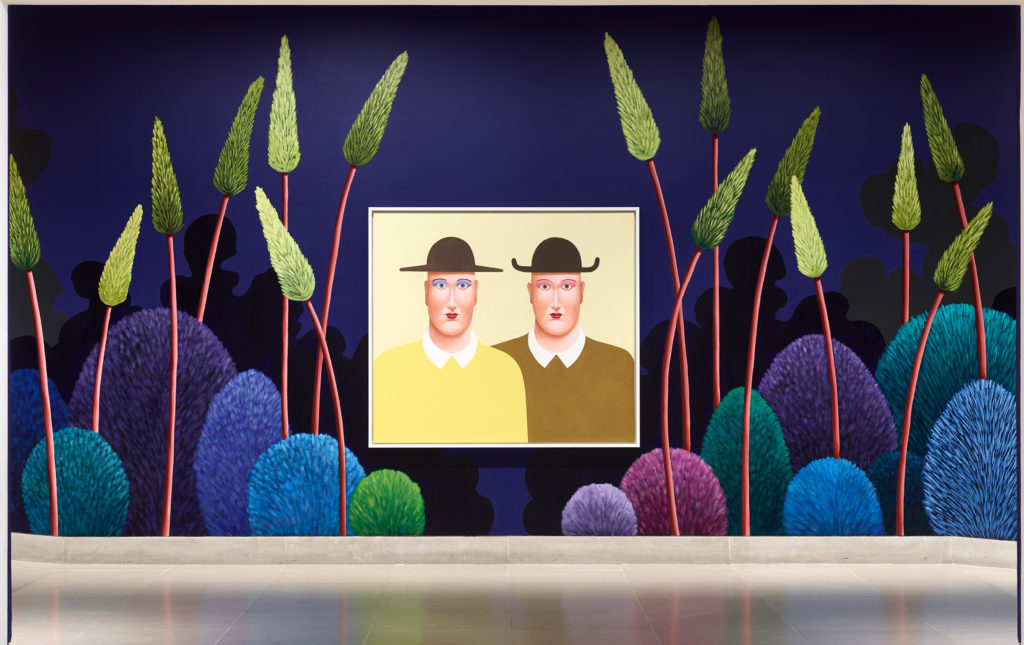
Nicolas Party, Pathway installation view, Dallas Museum of Art, 2016. Courtesy of the artist and The Modern Institute/Toby Webster Ltd, Glasgow. Photo: Chad Redmon
It’s much scarier to take risks when you have nothing, I feel more creative now. I have more space to try things, though I also have more to lose. But, you know, if I need to sell two paintings to [break] even, it’s okay—that’s when you can experiment. People always say, “Oh, it’s not going to last,” but when you’re in love, you never say, “Oh, in two years this will crash, she’s going to cheat on you or you’re going to have fights.” That’s how I feel: You just have to enjoy it now.
So you’ve got a lot of big shows coming up, but you also have one project in the works that is different from the rest: a recent commission by the nonprofit organization RX Art to paint a 207-foot hallway in a Los Angeles children’s hospital, where 16,000 kids walk every year on their way to surgery. How do you approach something like that?
It may not be a hip gallery in Chelsea, but [it was meaningful] to get that commission. It’s visually quite scary, because of what it represents, for children and their parents and caretakers to have to walk down it—even if you can change it in a tiny way, and help even a few people, that’s a big thing.
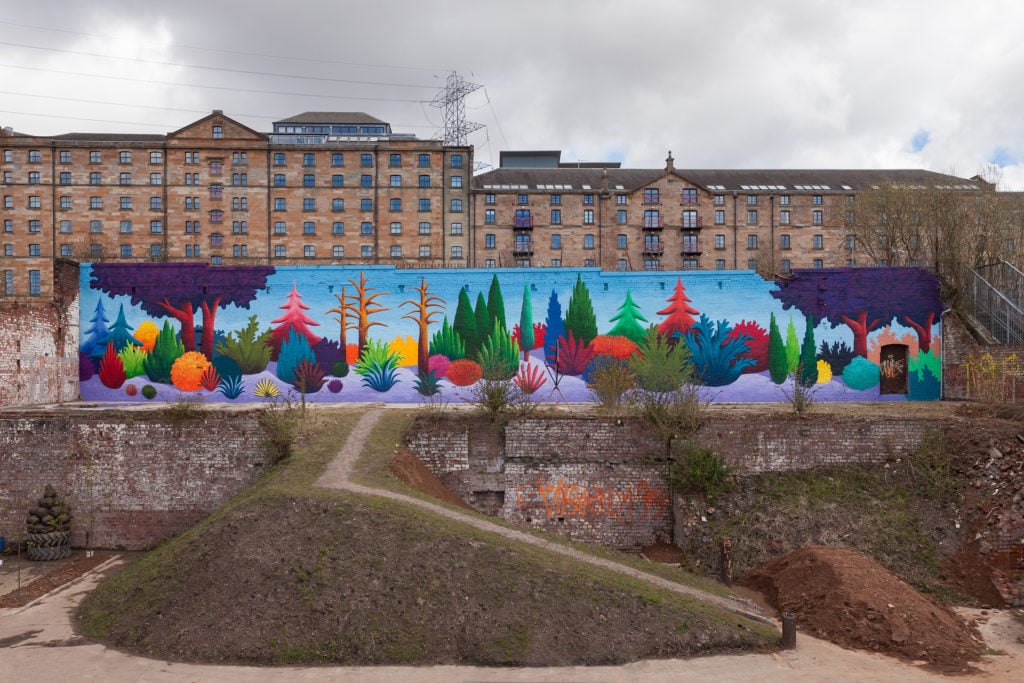
Nicolas Party Landscape (2013). Courtesy of the artist.
I love art, and I believe 100 percent in its power, because it affects me on a daily basis. I think in culture, music is by far the most direct thing that can help people tackle emotions. But visual art can affirm an idea, and certain elements can really help change your mindset. You have to be modest and humble, because you know that even if you do something [great] for this hallway, everything is not going to be okay. We all know that if you’re a kid and you have to go to surgery, it’s not the place that you’re supposed to be. But the idea is to create an environment that could help even a tiny bit in those dark moments.
To end on a lighter note, your name is Nicolas Party, and that’s a name that people love to play with. What is the best pun on your name that you’ve heard, and what is the most annoying one that you keep on hearing?
I don’t think it’s that easy to make a very good one. But anyway, it’s a fun name and a party is a good thing.